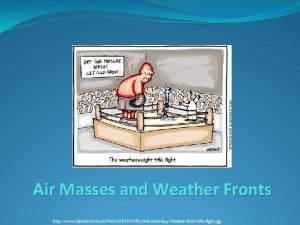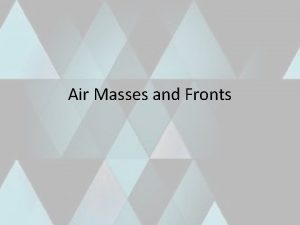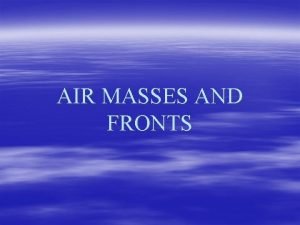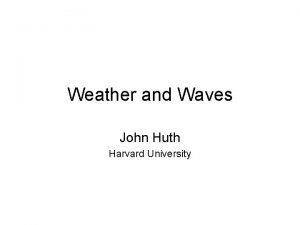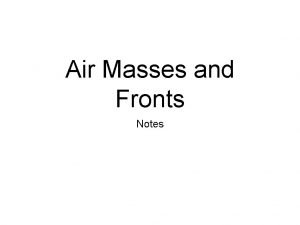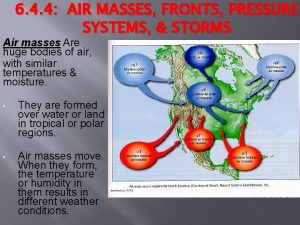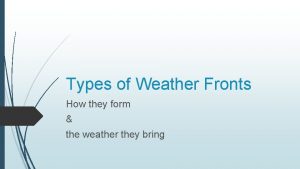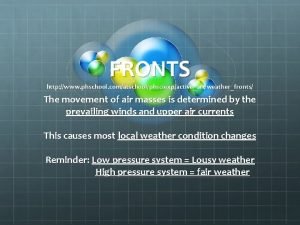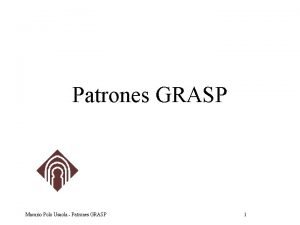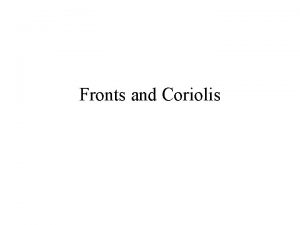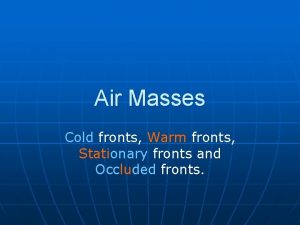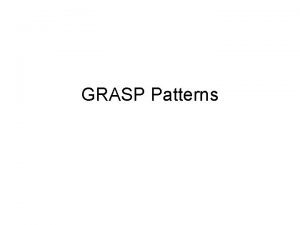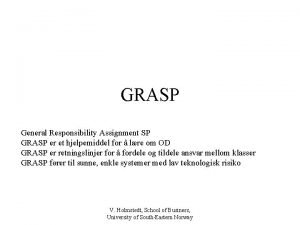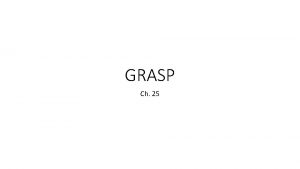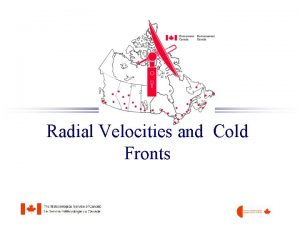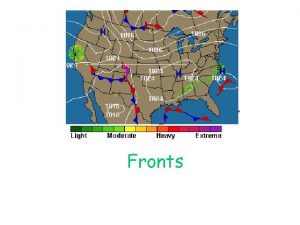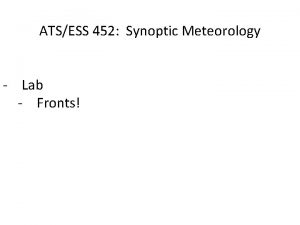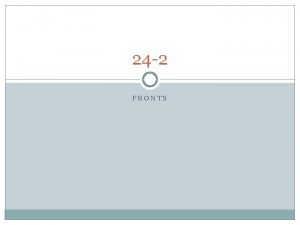Understanding Fronts A 3 D grasp on fronts










































- Slides: 42

Understanding Fronts A 3 -D grasp on fronts and frontal movements and cyclones

Air Masses ► An air mass is a defined as a large body of air with very similar characteristics. ► Generally speaking, air masses are generally defined by temperature and dewpoints (moisture parameters. ) ► Air masses are named based on the source region of the air mass itself

Types of Air Masses ► Continental Polar, “cold and dry” ► Continental Tropical, “warm and dry” ► Maritime Polar, “cold and damp” ► Maritime Tropical, “warm and humid” ► Arctic, “very cold” § Originates closer to the Poles over land -locked regions. § Originates closer to the Tropics over land-locked regions. § Originates closer to the Poles over water. § Originates closer to the Tropics over water. § Originates in the very cold land-locked areas

Analyzing Air Masses ► An air mass is most easily identified by comparing it to other air masses. ► Air masses can be modified with time, most notably by days of sunshine or lack thereof. ► Fronts are the dividing line between air masses so understanding air masses, means understanding where fronts are located.

What is a Front? ► Definition: A boundary, between air masses with different density. ► Commonly associated with … § § § Humidity/Moisture Temperature Wind shift Pressure Convergent boundary

Rules for finding fronts strong temperature differences. The front is located on the warm side ► Likewise, look for a strong dew point (hummidity) gradient. The front is located on the moist side ► Generally found in a pressure trough – look for three hour pressure changes. Fronts will show a decrease in pressure followed by a rapid increase in pressure after the frontal passage. BARAMETRIC PRESSURE ► Look for a sharp change in wind direction. ► Check weather and cloud patterns that are usually associated with different kinds of fronts ►

Types of Fronts ► Cold ► Warm ► Stationary ► Occluded § Noted by cold air advancing and displacing warmer air that exists. § Noted by cold air retreating from an area. § While differing air masses exist along a boundary, little movement is analyzed of the air masses. § A complicated process where the surface low becomes completely surrounded by cooler/cold air. Occlusion processes can be a “cool type” or “cold type” (more later. )

Cold Front ► Marked on a map with a blue line and blue triangles pointing towards the warm air. What is happening? Cumulus & cumulonimbus clouds form ahead of the front in the warm air, producing showers and thunderstorms. Weather passes quickly.

Cold Front ► Why? ► Cold air behind the front is moving in pushing warm air up ahead of the front. http: //www. physicalgeography. net/fundamentals/7 r. html

Cold Front ► An animation:

Warm Front ► Marked on a map by a red line with red semi-circles pointed towards the cool air (in the direction the warm air is retreating to. ) What is Happening? Associated with stratus type clouds, overcast skies, fog, and light rain or snow. Takes a while to move through.

Warm Front ► Simple 3 -D idea: http: //www. physicalgeography. net/fundamentals/7 r. html

Warm Front ► An animation:

Warm Fronts Vs. Cold Fronts https: //www. youtube. com/watch? v=G 7 Ewqm 0 YHUI

Stationary Front ► Marked by alternating blue lines & blue triangles (pointed in the direction of the warmer air) and red lines & red semi-circles (pointed in the direction of the cooler air) ► Stationary fronts are rarely ever completely stationary. It tends to meander a bit.

Stationary Front What is happening? Warm air mass and a cold air mass meet and have a stand off. Can remain in an area for days. Why? Stationary front form when cold air and warm air meet, but neither one has the strength to move each other. Where they meet water vapor condenses into rain, snow, fog, or clouds.

Occluded Front ► Marked by a purple line with alternating purple triangles and purple semi-circles, all pointing in the direction of the frontal movement. ► There are two general types of occlusions, cool-type and cold-type.

OCCLUDED FRONT What is happening? Colder air pushes towards cool air trapping warm air in-between the two air masses. The ground remain cool while air higher up is warmer. This forms complex weather systems. Why? A warm air mass is caught between and is pushed up by the two cooler air masses.

Occluded Front ► Simple 3 -D idea: http: //www. physicalgeography. net/fundamentals/7 r. html

Occluded Front http: //www. free-online-private-pilot-ground-school. com/images/occluded-front. gif

Cyclones: Putting it all together ► There are two types of cyclones, tropical/warm core and extratropical/cold core. ► Extratropical cyclones are characterized by having differing air masses frontal movements where tropical cyclones do not. ► We will concern ourselves with extratropical cyclones in this presentation.

Cyclones: Putting it all together ► Typically, cyclones are represented by using the Norwegian Cyclone model. It is simplistic, but a good way to start when understanding surface lows and cyclones. ► Students must begin to understand the four dimensional view of a cyclone § § North-South East-West Up-Down Time

The cyclone

Cyclones: Norwegian Model ► Step 1: A subtle boundary exists Surface View Images source: http: //www. srh. noaa. gov/jetstream//synoptic/cyclone. htm 3 -D View

Cyclones: Norwegian Model ► Step 2: A wave forms on the boundary Surface View Images source: http: //www. srh. noaa. gov/jetstream//synoptic/cyclone. htm 3 -D View

Cyclones: Norwegian Model ► Step 3: Cyclone becomes mature Surface View Images source: http: //www. srh. noaa. gov/jetstream//synoptic/cyclone. htm 3 -D View

Cyclones: Norwegian Model ► Step 4: The occlusion process Surface View Images source: http: //www. srh. noaa. gov/jetstream//synoptic/cyclone. htm 3 -D View

Cyclones: Norwegian Model ► Step 5: Cold air dominates, near the end. Surface View Images source: http: //www. srh. noaa. gov/jetstream//synoptic/cyclone. htm 3 -D View

Cyclone: On satellite

Cyclone

Cyclone ► Radar & Satellite view of a cyclone Occlusion Warm Front Cold Front

A cyclone centered just south of Wichita, KS. Fronts well developed

The cyclone six hours later, near Kansas City. A mature cyclone at this point with well developed fronts. Do you see them?

Another six hours, the cyclone (low) is beginning to occlude. The surface low is being surrounded by the colder air.

Another six hours, the cyclone (low) is now fully occluded. The surface low is completely within the colder air mass.

Another six hours, the cold front has surged well east while the center of the cyclone has remained over the Midwest.

Animation of a cyclone

Review: Finding the fronts Rule number one for finding fronts was to look for a strong temperature gradient or change in temperature. ► Do you see one here? ► Would you agree that the air mass in the Dakotas is not the same as the one that exists near Kentucky? ►

Review: Finding the fronts Rule number two for finding fronts was to look for a strong dewpoint gradient, or change. ► Do you see one here? ► If so, is it roughly in the same location as the temperature gradient in the previous slide? ►

Review: Finding the fronts Rule number three for finding fronts was to look for a strong pressure gradient, or change. Strong falls followed by strong rises. ► Rule number four is to look for a strong wind shift (the yellow vectors. ) ► Do you see these here? ► Note: in this image, the dashed blue lines represent pressure rises while the solid blue lines represent pressure falls. The numbers represent millibars per three hours of fall or rise. The yellow vectors point in the direction the wind is blowing towards.

Review: Finding the fronts ► The last rule is to check cloud and weather patterns.

Review: Finding the fronts Every cyclone presents unique characteristics. ► While the satellite and radar didn’t show the front well, the temperature, wind, and moisture analyses provided a clear cut picture of where this front should be analyzed. ► The rules for finding fronts should not imply that all the rules need to be met. It means that you need to use all those tools to find a front. Often, fronts are very subtle and only one rule might be useful. ► Did you get it right? ►
 Air masses in north america
Air masses in north america Non cutting instruments in dentistry
Non cutting instruments in dentistry Occluded front
Occluded front Air masses and fronts
Air masses and fronts Weather fronts symbols
Weather fronts symbols Types of air masses
Types of air masses Four types of fronts
Four types of fronts Weather fronts animation
Weather fronts animation Cold and warm fronts
Cold and warm fronts Air mass
Air mass Traditional drawer construction
Traditional drawer construction Fronts
Fronts Fronts and pressure systems
Fronts and pressure systems Picture of a warm front
Picture of a warm front A pattern of meteorological symbols that represent weather
A pattern of meteorological symbols that represent weather North american air masses
North american air masses Air masses and their characteristics
Air masses and their characteristics Warm fronts
Warm fronts Norwegian cyclone model
Norwegian cyclone model Occluded front drawing
Occluded front drawing Www.phschool.com
Www.phschool.com Occluded front animation
Occluded front animation Patrones grasp
Patrones grasp Patrones grasp
Patrones grasp Quadraped grasp
Quadraped grasp Pure fabrication domain model
Pure fabrication domain model Whenever you grasp a stretcher or backboard
Whenever you grasp a stretcher or backboard Who is she
Who is she Grasp design patterns
Grasp design patterns Enamel hatchet vs chisel
Enamel hatchet vs chisel Grasp principles
Grasp principles Grasp principles
Grasp principles Hand skill
Hand skill Grasp patterns
Grasp patterns Instrument grasp
Instrument grasp 2 finger pincer grasp
2 finger pincer grasp Ticra grasp
Ticra grasp Modified pen grasp in dentistry
Modified pen grasp in dentistry Stages of drawing development
Stages of drawing development Patrones grasp
Patrones grasp Easy to grasp
Easy to grasp Creator grasp pattern
Creator grasp pattern Patrones gof ejemplos
Patrones gof ejemplos


